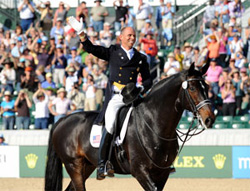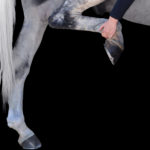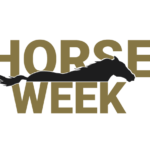
October 15, 2010 — Rob Hinkle knows first-hand the realities of that old axiom, “What goes up must come down.” He is spending the next few weeks supervising dismantling of the Alltech FEI World Equestrian Games’ giant exoskeleton.
All over the Kentucky Horse Park, bleachers are being folded up, tents collapsed to ground level and generator units toted to a parking lot, where they stand in rows.
There were 400 temporary structures put up for the WEG, and about 57 miles of cable strung underground, all of which must be removed. A strict schedule must be followed for contractors doing the work, as items inside the structures have to be removed before they come down.
The driving arena, where just a few days ago stands were full of people watching the world championship’s cones phase, soon will be a pristine polo field again.
The Media Village is disappearing. Seating at the main stadium must revert to pre-Games level.
Even when the temporary structures are gone, the park will never be the same, of course. The legacy of the WEG is far more than the discovery of the facility by horse lovers around the world. It also includes such permanent improvements as the Alltech Arena, where reining and vaulting were held, as well as vast intra-park road upgrades that will help traffic flow more smoothly at the many events the Horse Park is hosting now and in the future.
But first, there are about six weeks of work before the Horse Park can just be the Horse Park again, though likely it will be the end of the year before Rob’s key role on the project is wrapped up.
Post-WEG involves switching gears for Rob, whose job involved overseeing everything from security to restrooms to cleaning, in addition heading the logistics crew involved with the building and operation of a mini-city that hosted more than 500,000 visitors during the WEG.
After the dismantling is complete, there will be a sale of items such as tables and chairs that were purchased instead of rented because that presented a cost savings. He’s involved with that, too.
Rob’s parade of 18-hour days started in August and continued through the WEG. He often snatched a few hours of sleep at the Park’s campground rather than going home. While he and his crew would have enjoyed “a really big party” the night that the WEG closed, that couldn’t happen.
“There’s really no rest,” he said, explaining that the dismantling had to start early on the morning of the next day.
The WEG’s construction and operation involved 30 full-time staff and temps who had worked other major events, such as the Vancouver Winter Olympics. There were about a total of 100 people working at peak times.
It’s been intense and exhausting, but as Rob noted, “What’s gotten us by is building something and having people here to enjoy it.”
The end of the WEG, so many years in the planning and the making, represents a life change for Rob.
“By the end of the year, I’ll be unemployed,” he explained.
“I’m looking at different opportunities right now.” After being associated with the Horse Park in one capacity or another for more than 15 years, he noted, “I’m ready to move on to the next challenge.”
What will it be? Rob, who is ready to move if he has to, doesn’t know yet, but mentioned, “I’m interested in doing events. I’ve been working in the horse world for a long time. I’d like to find something within that industry.”






